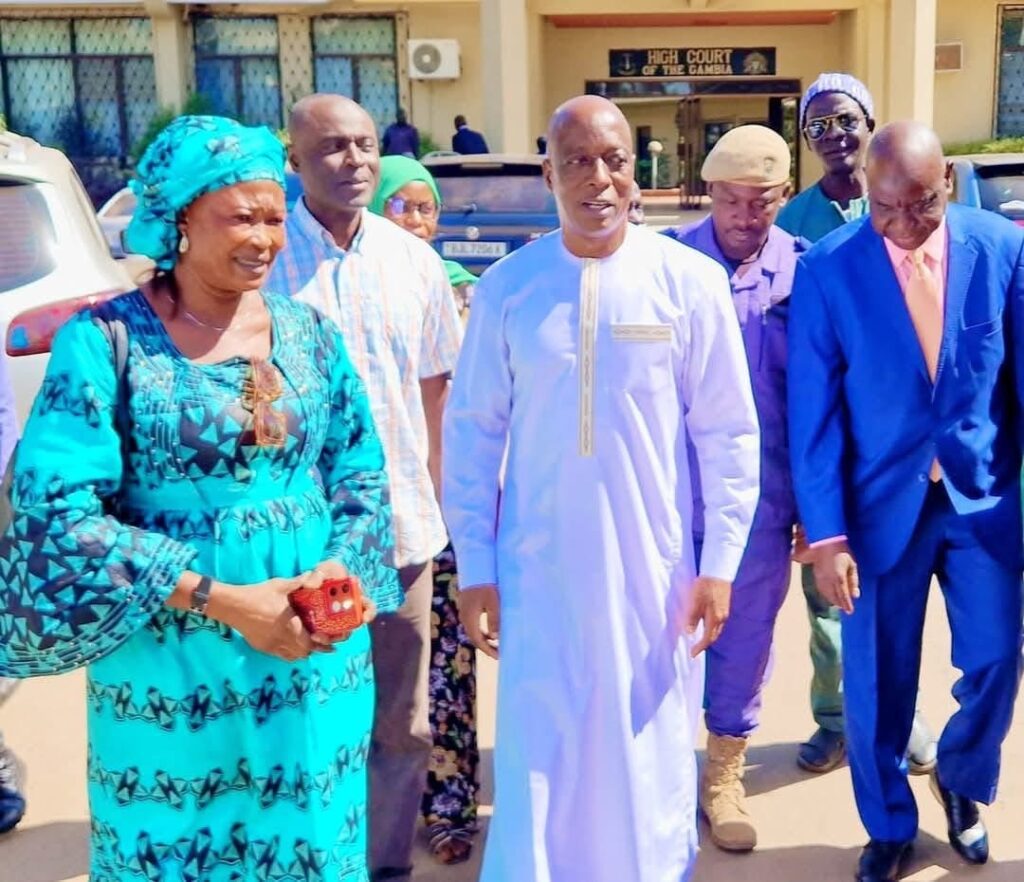DPP Urges Supreme Court to Uphold Yankuba Touray’s Conviction and Sentence

Yankuba Touray in court
Abdul Maita Yusuf, the Director of Public Prosecutions (DPP), has called on the Supreme Court to dismiss the appeal filed by Yankuba Touray and uphold both his conviction and death sentence for the murder of Ousman Koro Ceesay.
In his closing remarks, DPP Yusuf urged the court to reject Touray’s appeal as the case was adjourned for judgment. He emphasized that Touray’s involvement extended far beyond merely participating in the assault on Ceesay, highlighting the gravity of his role in the crime.
“He (Yankuba) also took part in disposing of the body of the Deceased by burning the same,” Yusuf stated.
Touray was charged with murder under Section 187 of the Criminal Code. On July 14, 2021, the High Court convicted him of murdering Ousman Koro Ceesay and sentenced him to death. Following the conviction, Touray appealed to the High Court, but the Court of Appeal upheld the verdict on December 13, 2022. Dissatisfied with the outcome, Touray filed an appeal to the Supreme Court on December 22, 2022.
DPP Yusuf argued that the Court of Appeal’s judgment was based on sound legal reasoning and should stand. He insisted that the decision was correct and warranted no changes.
Summarizing the case, DPP Yusuf recounted that Edward Singhateh, Peter Singhateh, Yankuba Touray, and the late Ousman Koro Ceesay were all members of the defunct Armed Forces Provisional Ruling Council (AFPRC), with Ceesay, a civilian, serving as the Minister of Finance at the time of his death in June 1995.
“On June 24, 1995, Yankuba Touray, in collaboration with Edward and Peter Singhateh, lured Ousman Koro Ceesay to Yankuba Touray’s residence in Kerr Serign, West Coast Region. Upon his arrival, Edward Singhateh, Alagie Kanyi (Prosecution Witness 6), B.K. Jatta, Tumbul Tamba, Pa Louis Gomez, Peter Singhateh, and Yankuba Touray attacked the deceased with a pestle-like object and other items until he succumbed to his injuries. Acting on Edward Singhateh’s instructions, Alagie Kanyi, along with B.K. Jatta, Tumbul Tamba, and Pa Louis Gomez, placed Ceesay’s body in his official vehicle.
The following day, June 25, 1995, Ousman Koro Ceesay’s vehicle was discovered along the Sukuta-Jambur highway, completely burned. The body inside was charred beyond recognition. Authorities publicly announced through radio and newspapers that the vehicle had been involved in an accident, reportedly overturning.
Meanwhile, Prosecution Witness 6 and others were ordered to clean the bloodstains in Yankuba Touray’s house. Edward Singhateh, Peter Singhateh, and Yankuba Touray then left the scene with Ceesay’s body.”
On July 1, 2019, Yankuba Touray was charged with a single count of murder under Section 187 of the Criminal Code. He entered a plea on July 8, 2019, denying the charge.
Touray’s defense is that on the day of the alleged incident, he attended a meeting with the Chairman of the AFPRC, Yahya Jammeh, at the State House in Banjul. As Chairman Jammeh was scheduled to travel to Ethiopia that day, Touray joined Jammeh’s car, accompanied by his driver, to the airport.
Touray further claimed that after Chairman Jammeh’s departure, he returned to the State House in Jammeh’s car, along with the driver, Pa Malang. He stated that he arrived at the State House around noon, where he conversed briefly with Lang Tombong Tamba before driving to his residence in Kerr Serign. Upon reaching home, he found his wife with two other individuals watching television. Touray also mentioned confronting his orderly, Jali Musa Sowe, for arriving late to work that day.
The High Court judge convicted Yankuba Touray of the murder of Ousman Koro Ceesay, finding that the evidence presented by the Prosecution demonstrated his involvement in conspiring with Edward Singhateh and Peter Singhateh to kill Ousman Koro Ceesay.
The judge also concluded that PW6 (Alagie Kanyi), along with the accused Edward Singhateh, Peter Singhateh, BK Jatta, Pa Louis Gomez, and Tumbul Tamba, used a pestle to strike Ousman Koro Ceesay at Yankuba Touray’s house.
Additionally, the judge determined that Yankuba Touray had failed to prove an alibi, as the testimony of Prosecution Witness 1 placed him at the crime scene. As a result, he was sentenced to death.
The Court of Appeal, in a unanimous decision, upheld both the conviction and the sentence.
Delivering his arguments before the apex court, DPP Yusuf stated that Yankuba Touray was not convicted solely based on the uncorroborated testimony of Alagie Kanyi. He explained that the court’s decision was grounded in the fact that Kanyi’s testimony was significantly supported by the evidence provided by other prosecution witnesses. He emphasized that Kanyi’s evidence was corroborated by these additional witnesses, which was crucial in upholding his conviction by the Court of Appeal.
Section 179 of the Evidence Act defines corroboration as follows:
“Corroboration consists of independent evidence from which a reasonable interference can be drawn which confirms and supports in some material particular the evidence to be corroborated and connects the relevant person with the offence, claim or defence.”Yusuf referred to the testimony of Alagie Kanyi, highlighting that the records clearly show the Deceased was a Cabinet colleague of both the Appellant and Edward Singhateh. He emphasized that the Deceased was not an ordinary citizen in The Gambia, as he served as the Minister of Finance at the time.
Yusuf further stated, “The Appellant [Yankuba Touray] and his co-conspirators ensured that no investigation was carried out about the death of the Deceased for over 20 years. The evidence of PW5 shows that when he began investigations into the death of the Deceased, he was summoned by the Appellant to his office. He gave evidence of how the Appellant looked at him and asked him to leave his office. PW5 gave an account of how he was dismissed from the Gambia Police Force shortly after he visited the office of the Appellant.”
Yusuf questioned why Yankuba Touray and his Cabinet colleagues failed to launch an investigation into the Deceased’s death, suggesting that if they had nothing to hide, they would have allowed the investigation to proceed. He also raised the issue of why those who began investigating the case were dismissed from the Gambia Police Force.
“It is our submission”, Yusuf concluded, “that if the Appellant had nothing to hide about the death of the Deceased, investigations would have been allowed to go on without any form of intimation towards the investigators or dismissal as in the case of PW5.”
He added: “It is our submission that the above pieces of evidence are independent of the evidence given by PW6. The said evidence and circumstances do not rely on the evidence of PW6.”Yusuf stated that the evidence presented by the Prosecution reveals a conspiracy involving Edward Singhateh, Peter Singhateh, and Yankuba Touray to assassinate Ousman Koro Ceesay.
Alagie Kanyi testified about a meeting at Edward Singhateh’s house, where they were briefed by Singhateh on their mission to eliminate Ousman Koro Ceesay. Kanyi’s testimony shows that they then traveled to the Appellant’s residence, which was empty at the time, with no guards or family members present.
Yusuf highlighted that the testimonies of PW2, PW3, and PW4 clearly show that Yankuba Touray ensured his residence’s guards and family members were absent.
“PW3, who was the Guard Commander in the Appellant’s residence, gave evidence that the Appellant instructed him over the telephone in his house to take the guards on patrol to the beachside as there was a boat on the sand beach. He also gave evidence that the Appellant also informed him that he should pick up his family members from the house and take them to the residence of Edward Singhateh as there was a party at the said residence.
PW3 further testified that the Appellant told him that he was sending a vehicle which he should use to take the family members to Edward Singhateh’s residence at Cape Point, Bakau. Additionally, PW4 and PW2 said that the Appellant asked them to go to his residence as he was not going to the Airport with them. Both PW2 and PW4 corroborated the fact that all the members of the Appellant’s family at his residence were taken to the residence of Edward Singhateh on the basis that there was a party going on there.
PW2, PW3 and PW4 also confirmed that they went on patrol to the beach as instructed by the Appellant. They also confirmed that when they returned to the residence of the Appellant from the patrol, they found cars parked outside the house. PW3 stated that when he went inside the residence, Edward Singhateh instructed him to return to the patrol with the guards, which they did.
PW6 (Alagie Kanyi) testified that after the Deceased was struck with a pestle until he fell and died, they were instructed by Edward Singhateh to place the body of the Deceased in the Deceased’s official vehicle, which they did. PW6 also gave evidence that when they placed the body of the Deceased in the vehicle, they went inside the Appellant’s house to clean the blood therein. He testified that when they finished cleaning the house, they went outside but found that Edward, Peter and the Appellant had left with the vehicles that were parked outside. PW2, PW3, PW4, PW5, PW6, PW7 and PW9 all testified that the car of the Deceased was found along the Sukuta-Jambur Highway burnt to ashes. Their evidence shows that the body of the Deceased was charred beyond recognition. It was ashes and bones of the Deceased which were recovered from the burnt vehicle and presented for medical examination.” the DPP argued
Yusuf argued that the evidence and circumstances presented clearly indicate that Yankuba Touray was involved in attacking Ousman Koro Ceesay with a pestle at his residence.
“It is also clear from the evidence that after the Deceased was struck with a pestle on many occasions his body was placed in his official evidence.”He further stated that there is evidence showing that Ousman Koro Ceesay’s body was taken by Edward Singhateh, Peter Singhateh, and the appellant.
“This is supported by the evidence of PW6 that the Appellant, together with Edward and Peter Singhateh, left with the body of the Deceased after he was killed in the residence of the Appellant. Additionally, the evidence of PW5 shows that the vehicle of the Deceased and that of Edward Singhateh were seen heading towards the Sukuta-Jambur Highway at around 1 am on 26 June 1995.”DPP Yusuf further argued: “It is our submission that the above evidence not only shows that the Appellant actually took part in the crime of killing the Deceased by hitting him with a pestle, but he also participated in the scheme to dispose of the body of the Deceased by burning the body beyond recognition to conceal the crime. All the prosecution witnesses confirmed that it was announced over the radio and newspapers that the vehicle of the Deceased was involved in an accident.
However, the evidence of PW5 and PW7 as experienced police investigators shows that the said vehicle could not have been involved in an accident as it was announced. Their conclusion was based on the fact that the car had no dents or anything which could suggest that the Deceased was involved in an accident. It is our submission that the circumstances of this case clearly prove that the Appellant, with his co-conspirators, burnt the body of the Deceased to cover up their heinous crime of killing their colleague State Minister. It is our submission that the Appellant took an active part in not only beating the Deceased to death but that he also took part in burning his body beyond recognition to cover his crime.”

